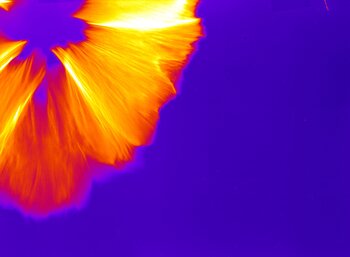This decommissioned ERA site remains active temporarily to support our final migration steps to https://ualberta.scholaris.ca, ERA's new home. All new collections and items, including Spring 2025 theses, are at that site. For assistance, please contact erahelp@ualberta.ca.
- 591 views
- 528 downloads
A Proton Flower from the Titan Laser
-
- Author(s) / Creator(s)
-
When an ultra-intense laser hits a solid target, jets of particles stream off in all directions. Hydrogen, as the lightest element, gets preferentially accelerated, resulting in proton beams. These beams have many potential applications, from medical radiotherapy to fusion energy. The study of their dynamics and optimization has been the focus of my degree. In this false colour image, a beam of protons has been recorded by radiochromic film. The protons were moving at 10% the speed of light. The intense fields of the laser, along with the magnetic fields generated by expanding plasma, lead to a distinctive ring structure. Meanwhile, magnetic field instabilities cause filamentation of the particle beam and the clearly visible line features. The colour set chosen, “fire”, is the standard used by experimentalists in the field to highlight features in data. // Program of Study: PhD // Faculty/Department: Electrical and Computer Engineering // Place of creation: Jupiter Laser Facility, Lawrence Livermore National Laboratory, California, United States // Award: Semi-finalist Prize, Images of Research Competition 2017
-
- Date created
- 2017-01-01
-
- Subjects / Keywords
-
- Type of Item
- Image
-
- License
- Attribution 4.0 International
